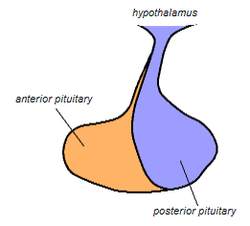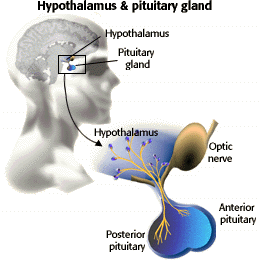Posterior pituitary Definition
It is a section of the endocrine system that comprises of the posterior lobe of the pituitary gland. It is also known by the name “neurohypophysis.”
Posterior pituitary Location
It is the rear or posterior part of the pituitary gland, a small gland located in the head (also referred to as the master gland).
Posterior pituitary Anatomy
It is mainly a cluster of axons or neuronal projections that extend from the neural structure known as the hypothalamus. It is primarily classified into:
Pars nervosa
This section comprises of the most part of the neurohypophysis. It stores vasopressin and oxytocin. It is sometimes mistakenly equated with the Posterior pituitary. It contains the pituicytes and the Herring bodies.
Infundibular stalk
It is also referred to as the pituitary stalk or infundibulum. It joins the hypophyseal and the hypothalamic systems.
Median eminence
It is included as part of the neurohypophysis, although only occasionally.
Posterior Pituitary – Hormones
There are two hormones that are secreted by the posterior pituitary – Anti-Diuretic hormone (ADH), and Oxytocin.
Anti-Diuretic hormone
Produced by Supraoptic Vasopressinergic neurons, the hormone is stimulated by raised osmolarity and low blood volume while suppressed by reduced osmolarity. The hormone helps in increasing the permeability of the collecting ducts that are present in the kidneys, thereby leading to re-absorption of water.
Oxytocin
Produced by Paraventricular oxytocinergic neurons, the hormone is stimulated by the stretch receptors in the cervix or the nipple and oestrogen while suppressed by stress. It leads to the smooth muscle contraction of the uterus that ultimately results in giving birth or the mammary glands that leads to milk ejection after the delivery of a child.
Posterior pituitary Function
It secretes the hormone known as Oxytocin that increases the level of ADH (antidiuretic hormone) and uterine contractions. It is the antidiuretic hormone that leads to an increase in the reabsorption of water by the kidney tubules. Reduced ADH production leads to Diabetes insipidus characterized by the inability to concentrate urine. This consequently results in excess urination, potentially causing dehydration. The neurohypophysis, thus, helps in maintaining urine concentration and balance of water in the body.
Posterior pituitary Problems
The neurohypophysis is associated with disorders like Diabetes insipidus in which the body loses the capability to concentrate urine.
Posterior pituitary – Clinical Significance
The ADH enables the kidneys to hold on to an adequate amount of water. The requirement of ADH, if not fulfilled, leads to the excessive loss of water from the body through urination. As a result, dehydration is caused that may reach a dangerous level with a high sodium level and enhanced thirst. This condition is referred to as Diabetes Insipidus or DI. On the other hand, when the ADH conserves more than enough water in the body, it lowers the sodium levels casing Syndrome of Inappropriate Antidiuretic Hormone Secretion or SIADH.
Syndrome of Inappropriate Antidiuretic Hormone Secretion
SIDH is caused in people who have suffered from heart failures or brain injuries, which affect the hypothalamus. The hypothalamus is the part of the brain that acts collectively with the pituitary gland to secrete or produce the hormone.
Causes
- Inflammation of encephalitis
- Inflammation of membranes that provide cover to the brain and the spinal cord
- Psychosis
- Certain medicines
- Head injury
- Lung disease
- Hereditary issues
- HIV, etc
Symptoms
- Memory issues
- Cramps or tremors
- Irritability
- Nausea
- Seizures
- Coma
- Depressed mood
- Moo change
- Diagnosis
To identify the condition, patients may be asked to go for a blood test and urine examination. Through this, the levels of sodium and potassium in the body could be identified along with the amount of substance that is dissolved in the urine or blood, the process of which is called osmolality.
Treatments
- Medication to block ADH action
- Surgery to remove the tumour that makes up ADH
Diabetes Insipidus
The condition arises when the water requirement for the body is not fulfilled. It is also referred to as water diabetes.
Types
- Central diabetes insipidus, which restricts the production of ADH due to the damage to the hypothalamus
- Nephrogenic diabetes insipidus, which witnessed unresponsiveness of kidneys to ADH due to use of medicines or chronic diseases
- Dipsogenic diabetes insipidus is related to the sense of thirst of a patient. More urine is produced
- Gestational diabetes insipidus, which occurs during pregnancy and goes away as soon as the baby is born
Causes
- Hypothalamus doesn’t produce more ADH
- Brain injury
- Tuberculosis
- Damage to hypothalamus
- Sarcoidosis
- Hereditary
- Blockage in arteries
- Inflammation of encephalitis
- Inflammation of membranes that provide cover to the brain and the spinal cord
Symptoms
- More than usual thirst
- More urination than normal
- Dehydration
Diagnosis
- Urine test
- Blood test
- MRI scan
- Water deprivation test
Treatment
- Synthetic ADH in the form of pill, nasal spray or injection may be given
- Medication to increase the production of ADH
- More intake of water
- Recording water intake and urine output
Posterior pituitary Pictures
Check out these images to know how this endocrine structure looks like.
Picture 1 – Posterior pituitary
Picture 2 – Posterior pituitary Image
References:
http://en.wikipedia.org/wiki/Posterior_pituitary
http://www.medterms.com/script/main/art.asp?articlekey=9709
http://www.lpch.org/DiseaseHealthInfo/HealthLibrary/diabetes/ppdhub.html



It is a really great resource!A lot of useful information and handy tips, thank you =)